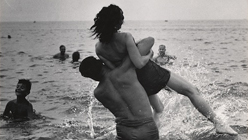One of my favorite photographs has always been a Garry Winogrand from 1964. It captures a couple in a convertible driving somewhere in Los Angeles. She is staring straight ahead, lips pressed together, with what appears to be a goose egg on her right cheekbone, although it could just be a trick of the streetlight. He’s driving, a butterfly bandage wrapped across the bridge of his nose, and he’s looking at her through narrowed eyes with a smoldering “just-wait’ll-I-get-you-home” expression on his face. What happened to this sad pair? I always wondered. Are they returning from the hospital where they went to get patched up after a domestic argument, or had he been too obnoxious to the wrong guy in a bar? Do they leave their unwashed dishes in the sink for days on end? And I bet he knows how to make a mean Old Fashioned, and she likes her whiskey sours.

Garry Winogrand, New York World’s Fair, 1964.
Winogrand’s photographs do that to you, or at least the best ones do. Instead of telling stories, his pictures invite them, thanks to their offhand, snapshot quality, where ambiguity and chance are worth a thousand decisive moments.
Some 300 Winogrand photographs, roughly 100 of which have been printed for the first time, are on view through June 2, 2013, at the San Francisco Museum of Modern Art. Supplemented by a fine catalog, the exhibition is beautifully organized and presented, dividing Winogrand’s work into his New York pictures from the 1950s and 1960s, his American photographs shot during the same decades and the output of his later years, from the 1970s through 1983. He died the following year at the age of 56.

Garry Winogrand, John F. Kennedy International Airport, New York, 1968.
From the beginning, Winogrand focused on the everyday, unimportant moments that make up the bulk of our lives. His prime studio was the sidewalk, particularly in Manhattan. There, Winogrand would snap, snap, snap, catching men in fedoras chomping fat cigars, as well as women who often seemed more interested in checking each other out than those hat-wearing smokers. Winogrand photographed couples, too, whether it was a young pair frolicking in the surf at Coney Island, a boy stealing a kiss from his girlfriend, or a stylish, prosperous couple, he with his hand under her elbow, she in her fur-trimmed toque, matching stole and white gloves.




